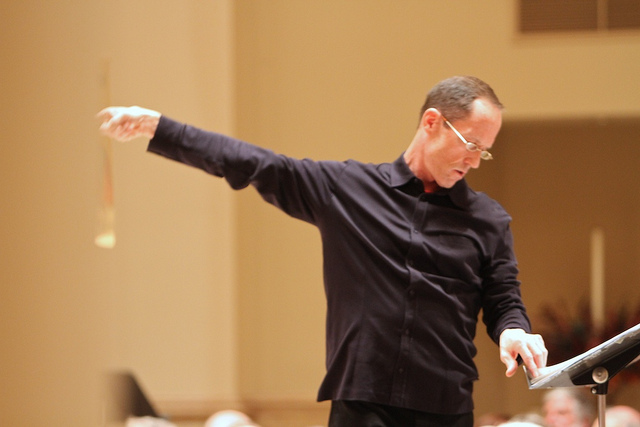Strings & Reeds & Ping Pong Balls
Present Music deftly handles six very different works and wins the game.
Sometimes the atmosphere created in an intimate chamber-music setting removes the barrier between active performer and passive listener. When the audience, seated on the stage, is close enough to touch the artists, the experience of breathing along with them and following their eyes from score to colleague puts listeners as close as they can be without actually playing. Artists feel their audience and commute that electricity into something ecstatic. Frank Zappa noticed that magic and once opined that “Music, in performance, is a type of sculpture. The air, in the performance, is sculpted into something.” Thus it was Thursday evening that the musicians of Present Music and its director, Kevin Stalheim, carved delight from the energized air at the Helene Zelazo Center for the Performing Arts at UW–Milwaukee’s Peck School of the Arts.
Present Music concerts are akin to a box of Gumpian chocolates—you never know what you’re going to get. However, it is a reliable bet that compelling compositions will give the audience some new aspect to music never previously considered. That is exciting.
The program opened with a work titled “The Yellow Pages” by Milwaukee native Michael Torke. Like a pot simmering on low boil, violinist Eric Segnitz, cellist Adrien Zitoun, flutist Jennifer Clippert, clarinetist William Helmers, and pianist Cory Smythe cooked up a bubbling stew of rhythm-driven minimalism that popped and grooved subtly around the circle of fifths, provoking pulsating intensity from the group. In the audience you could see a good deal of head bobbing, finger tapping, and foot bouncing along with the quintet.
The second work on the program was an oddity by Christopher Cerrone. His Sonata for Violin and Piano was well performed by Segnitz and Smythe, and while the work presented many technical challenges for the pair, it wasn’t until the second movement that anything meaningful took place. In the first movement, the music explored the possibilities of perpetual harmonic chirping from the violin and austere but constant motion from the piano. The second movement, marked Still and spacious, but always moving forward, had a Copland-esque spareness: Smythe’s piano rained single drops of prismatic light that Segnitz answered in harmonic flashes growing in frequency and intensity. The third movement, marked Dramatic, violent, rhythmic, very precise was on the redundant side. If this movement had been an email, the reader would have got it all by simply scanning it and skipping to the end.
Before beginning the second half, Stalheim and his musicians demonstrated some of Caroline Mallonée’s aural depictions of physical forces affecting a body in motion from her work “Unless Acted Upon.” The demonstration provided sonic guideposts for the audience which then heard the six movements played without pause, but, really, one twigged immediately to each delightful idea in this clever work. A bang in the piano set in motion the first movement, Newton’s Cradle, and the energy twittered back and forth from flute to violin. Friction ground with inevitability as Zitoun’s screeching-brake glissandos made the syncopated accompaniment yield. Gravity offered the distinct impression of weight, and Push felt like running pell-mell on ice. Conductor Stalheim articulated the movement Bounce by dropping Ping-Pong balls at precise points in the music, and Magnetism was richly portrayed with beautiful, deep sounds by Helmers and Zitoun as their canon drew ever closer together.
The second half of the program was a showcase for the talents of Helmers on both clarinet and bass clarinet. After his playing in the Mallonée, Helmers was magnificent in “Don Pullen Says It’s OK” by Ken Thomson. The piece, scored for bass clarinet and string quartet, began with Helmers’s soulful solo line. The orchestration of the tender melody in the bass clarinet, supplemented by the cello, created a hurdy-gurdy aspect, and this sound was accompanied by thrumming, descending scales in the violins and viola, imbuing the piece with a haunting beauty. Notably, Thomson’s composition required Helmers to play in the extreme high register of his instrument; he made it sound as easy as the rest of his lyrical playing.
The final work was Pierre Jalbert’s Trio for Clarinet, Violin, and Piano. Helmers was joined by Greenholtz and Smythe in this energetic composition. Smythe offers a great deal as a musician. He is worth his weight in gold for his rhythmic dynamism and technical prowess on the piano, and his artistic connectivity to others in the ensemble creates an immutable bond. Helmers, too, is reliably brilliant. His fearless demeanor comes from well-founded confidence that there is nothing he cannot play. He is expressive, creative, and technically sure-footed which—especially when playing trickier repertoire which is often the case for Present Music—lays a strong foundation for others to follow. If the arts gave out awards for quality musicianship, Helmers would be an annual MVP.
New to this reviewer’s ears as a chamber musician was the tremendous violin playing of Greenholtz. Her cadenza in the Jalbert showed off intelligent musicality, a wide array of beautiful tone colors, and total command of technical challenges that perfectly set the stage for a beautiful aria for Helmers and Smythe. The final movement was replete with clean, clear exchanges of wild thematic material covering several octaves and unison passages à la Zappa that erupted in outbursts of virtuosity, putting an exclamation point on a fun concert.
Review
-
Ouzo Café Is Classic Greek Fare
 May 23rd, 2024 by Cari Taylor-Carlson
May 23rd, 2024 by Cari Taylor-Carlson
-
‘The Treasurer’ a Darkly Funny Family Play
 Apr 29th, 2024 by Dominique Paul Noth
Apr 29th, 2024 by Dominique Paul Noth
-
Anmol Is All About the Spices
 Apr 28th, 2024 by Cari Taylor-Carlson
Apr 28th, 2024 by Cari Taylor-Carlson





















